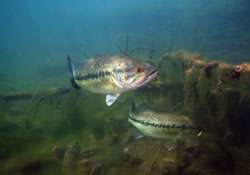
Whether it’s one fish following his hooked brethren back to the boat or the wake of a bass homing in on your surface bait, few things excite an angler like the sight of a following fish. On the flip side, the image of a following fish left unconverted has cost many an angler on the Tournament Trail a good night’s rest.
Honing your angling instincts to razor-sharp sensitivity is a prerequisite to making converts of mere followers.
One reason successful anglers consistently cash in on following fish is because they see them. Constantly alert to the flashes, shadows and surface subtleties that betray a fish’s presence, they are processing as much information when they are fighting fish as when they are reading a graph or a hydrographic map.
But just what should you do when fish follow? How do you convert a reluctant bass trailing your lure into weigh-in points? And how do you convince one or more of the fish that follow your hooked bass to join their buddy in the livewell? Following are the strategies the pros use.
COLOR, ACTION, SPEED
A bass putting his nose to a bait is clearly a sign of interest. But it’s also a sign that the fish perceives that something’s not quite right, or at least not enough to his liking.
Strategies for following fish generally fall into two categories: 1) opting for a different lure, or 2) fine-tuning the triggering mechanisms of size, speed, retrieve or color.
Dale Hollow smallmouth specialist Stephen Headrick advises anglers to prepare for followers by having a high-percentage alternative close at hand.
“Anytime I’m throwing a spinnerbait, I always have a Fluke tied on,” says Stephen Headrick, who also owns Punisher Lures in Celina, Tenn. Many times his Fluke will come through with a fish when the spinnerbait remains a mere curiosity.
Tommy Jacques, a bass pro from Wetumpka, Ala., has bass seeing red when he stops a spinnerbait in their face.
“When I notice fish following or popping a spinnerbait but not taking it, I will add a Daiichi Bleeding Bait Trailer Hook,” he says. “Most of the time, the skirt is long enough to cover the hook, but when it flutters, that red flashes.”
Changing presentation can help tap into the mood of the fish and produce rapid results.
“If a fish isn’t taking a bait, I try to fish faster,” says Tim Horton, the Elite Series pro from Muscle Shoals, Ala.
“I feel like it’s getting too good a look at the bait, so I speed my retrieve. If they’re hitting short on plastic baits (fished near the bottom), I may change colors or shorten my bait.”
A change of action is another way to make converts. Altering a retrieve pattern or opting for a bait with more radical, or even subtly enticing, action may produce fast results.
Nothing seems to seal the deal like the paroxysm of a dying baitfish. The magic of a well-worked jerkbait, hard or soft, has long been its ability to turn followers into strikers by imitating a baitfish on its last fins.
SWIMBAIT FOLLOWS
A number of lure makers have engineered their baits to make 180-degree turns during the pause. Elite Series angler Ish Monroe says that 180-action has been built into the Tru-Tungsten Tru-Life Swimbait that he helped design.
“The swimbait snaps back around and faces the fish, and that triggers a ferocious strike,” he says. “They try to murder it!”
Swimbait specialists have lots of experience with followers. They also have their own theories on the art of gentle persuasion.
“If you throw a swimbait eight hours in a day, you will have at least one follow, and, most likely, you will have a lot more,” says Monroe, who cashed in big-time on swimbait catches in his successful 2006 and 2007 seasons.
“It’s just the nature of the bait. It’s so realistic, it just attracts bass.”
But often the fish seem as mesmerized by the swimming action as an admiring angler — more curious than committed to a strike. That’s Monroe’s cue to make the bait do something different.
“Some days I will reel fast or snap the rod to make (the lure) walk to one side,” says the California pro. “Try to get a different angle or action out of the bait to make them strike. When fish see the bait trying to get away, they will oftentimes commit.”
PICK-UP PARTNERS: WHEN BASS FOLLOW BASS
Follow-the-leader bass — those that follow a hooked bass — call for a different pattern of thinking.
Fish following another fish is indication that there’s a school,” says Horton.
When he notes bass around his hooked fish, Horton takes note of the point at which he had hooked the fish and where he had cast.
“It may take three or four casts or a five-minute wait, but they will be back,” says Horton.
Tim Chandler, who guides on Alabama’s Tennessee River impoundments, says that following fish produce big days for his clients. When a bass has followers in tow, he leaves the fish in the water and instructs the client to flip a jig near the following fish. Often a second bass will hit instantaneously.
“In one tournament, my partner and I were flipping in grass no more than 8 feet away. He was bringing in a 5-pounder, and five more were following,” says Chandler. “He swung the fish aboard, and a 4-pounder came up to the top and just sat there 2 feet from the boat, looking up from the water. It was one of those slow-motion moments where everything seemed to stay as it was.
“Then I dropped my jig 2 inches below the surface and the fish was on.”
Follow These
Tru-Tungsten Tru-Life Swimbait,
TTI-Blakemore Daiichi Bleeding Bait Trailer Hook,
Pure Fishing Trilene 100 Percent Fluorocarbon,




